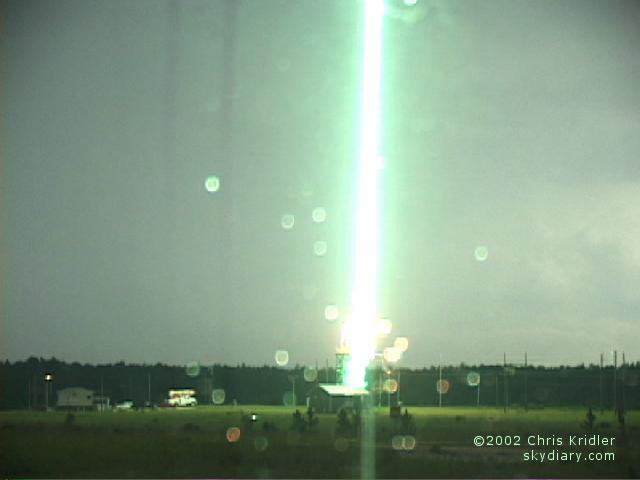手機引雷是個很嚴重的錯誤訊息. 手機是無法引發雷擊的! 打雷時使用手機會比使用有線電話安全得多!!!...
2004年7月23日, 大陸居庸關長城發生雷擊事件,多名遊客受傷送醫. 一時間兩岸出現了許多手機引發雷擊的報導, 還有許多專家解釋手機是如何引發落雷, 當中還不乏知名學者, 關於這點, 有大陸網友批評:"不但大陸的專家那麼糊塗, 台灣的所謂專家也胡說八道..."
事實上, 在這些傷亡的案例中, 受害人原本就位於容易遭受雷擊的地方.
大陸很喜歡用一些讓人覺得很烏龍的理由來推責任, 兩光機長偏離航向30度, 就說是機上乘客的手機干擾的, 抓不到電台裡偷偷播放法輪功帶子的人, 硬說台灣蓋台(衛星鏈路那有那麼好插呀?!) 長城雷擊事件, 官方發佈原因是手機引雷, 這不外又在掩飾官方的責任: 這樣一個觀光景點, 竟然沒有完備的避雷設施!
長城事件中 15 個人都只是昏迷, 顯然落雷並非直接命中, 而是透過地面傳導. 若真是手機引發雷擊, 恐怕會傷亡慘重吧...
在手機引雷的迷思中, 有許多錯誤的觀念必須釐清, 其一, 手機使用電池, 並未接線與大地導通, 因此不可能如傳說中所說的形成避雷針的效果. 再者, 手機的電波極弱, 無法解離空氣形成通路, 當然不可能引發雷擊.
如果無線電波會引發雷擊, 如果按照傳言所呼籲的逢雷雨手機關機, 那麼發射功率比手機更強的電視, 廣播發射台或雷達, 豈不是被雷打好玩的? 相信您也瞭解這並非事實.
如果我所說的您信不過, 那麼全世界最權威的氣像單位如何? NOAA 關於閃電安全有這麼一段話: Avoid talking on the phone (it is safe to use a cell phone or cordless phone) , 避免講電話(有線), 使用行動電話或無線電話是安全的... ( 全文 )
在打雷時要避免使用有線電話, 因為如果落雷擊中電話線, 電流會沿著電話線傳輸, 再由使用者手部或頭部進入人體, 造成嚴重傷害, 美國即因此造成不少傷亡. 所以打雷時只使用手機或是無線電話反而會比較安全.
所以, 放心的用手機吧...
再來, 介紹一下如何引雷...
底下這張照片是科學家利用帶有金屬導線的火箭射向雲層, 導線會形成通路, 誘發閃電擊中發射台.

比較新的做法正在測試中, 利用高能量雷射解離空氣形成通路, 但如何避免閃電損壞昂貴的雷射裝置是一大課題...
如果手機足以誘發雷擊, 又何必如此大費周章, 手機比火箭便宜多了...
附錄: NOAA 網站關於閃電安全(http://www.crh.noaa.gov/lot/?n=currents_summer2006#Lightning)
Lightning Safety
By Christopher Gitro, Meteorologist Intern
Did you know that that lightning claims the lives of over 70 Americans and injures more than 300 each year? More deadly than tornadoes and hurricanes, lightning is the second leading killer of people across the United States from storm related events. Between the years of 1995-2004, there were 12 lighting deaths in both the states of Indiana and Illinois. There are, however, many different precautions that people can take to minimize the risk of suffering injuries or even death from lightning.
What is lightning?
Lighting is caused by separate positive and negative electrical charges in the atmosphere. As the charge build up increases, the charges are eventually released in the form of lightning. As lighting travels through the air, the surrounding air is rapidly heated to over 50, 000 degrees Fahrenheit. This rapid heating produces a shock wave, resulting in what you hear as thunder. As the lightning is released, it zigzags its way towards the earth’s surface, traveling along randomly charged particles in the process.

There are precautions you can take to minimize the risk of being struck by lightning. If you’re out in the open and you begin to hear thunder, seek shelter in a sturdy structure away from windows. Open structures such as picnic shelters and baseball dugouts offer no protection from lightning. Avoid talking on the phone (it is safe to use a cell phone or cordless phone), washing your hands, or taking a shower. Try to stay away from any objects that may conduct electrical changes into your house or building. If caught outside and you are unable to find shelter, avoid being the tallest object. Never seek shelter under a tree or next to any metal objects such as flag poles or radio towers. If unable to find a structure and a vehicle is available, go to the vehicle and close all the windows and avoid touching any metal objects which may conduct electricity. If outside and you begin to feel a tingling sensation and your hair begins to stand up, immediately drop to the ground and squat on the balls of your feet. Place your hands on your knees with your head between them. Make yourself the smallest target possible and DO NOT LAY FLAT ON THE GROUND!
30/30 Rule
To help keep safe during thunderstorms, the 30/30 rule can be used as judgment of when it’s safe to venture outdoors. The 30/30 rule simply states that if thunder occurs within 30 seconds (6 miles) of a lightning strike, drop what you’re doing outside and go inside. Stay inside until at least 30 minutes after the last sound of thunder and/or lighting flash was seen.
Summary
As you can see, lightning is a serious threat to people living in northeast Illinois and northwest Indiana, especially those partaking in outdoor activities during the summer months. When thunderstorms threaten your area, seek safety indoors and stay there until 30 minutes after the last thunder was heard and/or lighting was seen. If caught outside, crouch to the ground with your hands over your knees and your head in between. If these and other safety precautions are taken, the number of lightning related injuries and fatalities will hopefully decrease across the United States.
For more information about lightning and lightning safety, go to www.lightningsafety.noaa.gov.

9/02/2010: 修正 www.lightningsafety.noaa.gov 連結(NOAA 自己都是錯的還沒改, 不能怪我!
 )
)相關話題:
站法大不同! 雷殛時的地面傳導
沒有留言:
張貼留言